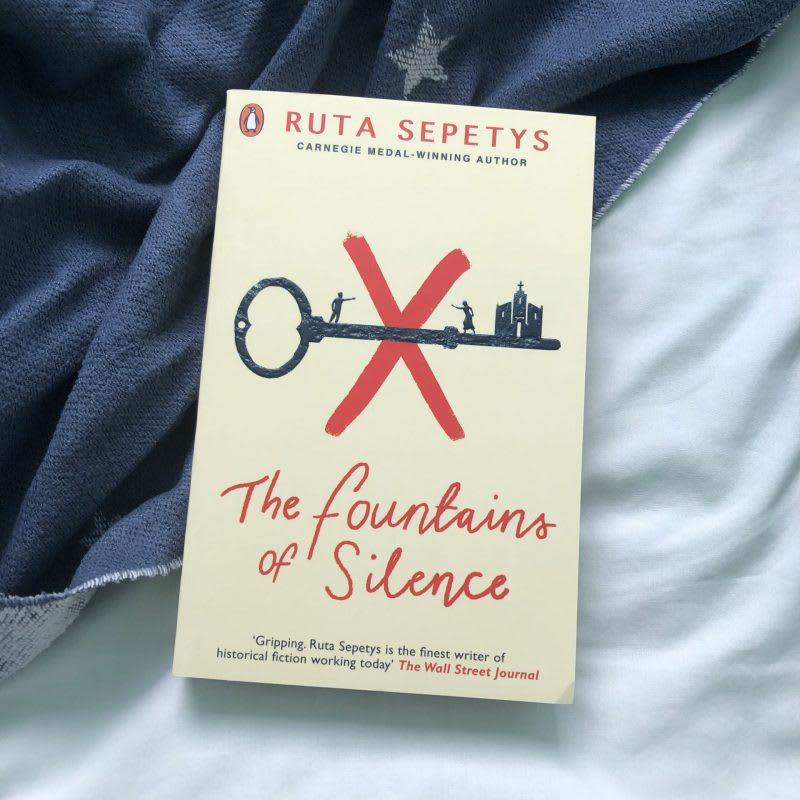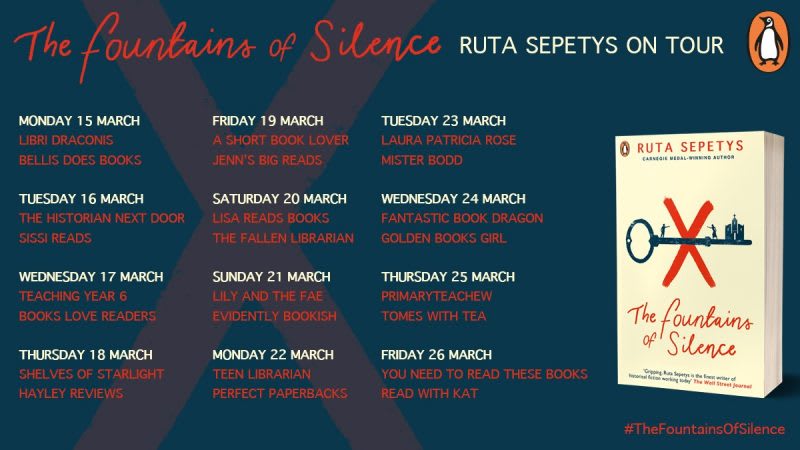Blog Tour: Fountains of Silence by Ruta Sepetys

In her latest novel Ruta Sepetys has tackled the difficult subject of life under General Franco’s fascist regime in Spain during the 1950s. Fountains of Silence is aimed at a young adult (and adult) audience and it beautifully weaves haunting real-life events with the fictional stories of hotel maid Ana and American tourist Daniel. These two young people are brought together in Madrid in 1957 as the dictatorship relaxes its rules enough to allow visitors back into the country after twenty years. But Spain is full of secrets and the trauma of Franco’s brutality still looms large over those who live there. This book is an elegantly realised account of the impact of Franco’s rule on ordinary people and it sheds light on the horrors that they suffered for decades
Sepetys is no stranger to writing about difficult historical events and her body of work includes the Carnegie Medal winning Salt to the Sea that tells the story of the deadliest maritime disaster, the sinking of the MV Wilhelm Gustlov, in 1945. Similarly, Fountains of Silence does not shy away from telling the readers a story a story that has been forgotten, ignored and, due to the agreement not to talk about Franco’s rule known as the Pact of Forgetting, deliberately repressed.
After the Spanish Civil War in the second half of the 1930s, Franco’s treatment of the defeated Republicans included a system of eugenics that was based not on race but on political association. This meant that children from Republican families were taken into state care or were sold into illegal adoptions to be raised by families who were loyal to the fascist state. These children are central to the main themes in Fountains of Silence as the main characters come to realise the truth about what was happening and the cruelty that was endured by the families who survived.
These events happened so recently that much of Sepetys’ research came from the oral histories told by those who lived in Spain during Franco’s regime and are only now beginning to share their stories. At Penguin’s author event I was able to ask Ruta why she thinks it is important to use historical fiction, particularly that aimed at young audiences, to shed light on the dark moments in history? And how, as an author, she makes the decisions about what to include and what to leave out when so much of her research contains events that are so horrific but also so important?

She responded that she feels that young readers are ‘deep thinkers and deep feelers’. She made the point that many of the books that she read as a teenager had such a strong impact on her that she still carries their effects with her today. So by writing about underrepresented histories for a young audience she hopes that they too will be touched by them and carry them forward too.
Acknowledging that that she could write non-fiction accounts of these events Sepetys finds that historical fiction allows her to represent many different perspectives. For Fountains she spent seven years interviewing over a hundred people and she pulled threads from those interviews to weave together composite characters in the hope that they represent a larger human experience. Instead of writing non-fiction that focuses on the enormously valuable experience of a single family, she sets out to cover as much of the experience from as many angles as possible and writing fiction gives her the freedom to do this.
On the subject of choosing what brutal details to include she jokingly calls herself ‘the queen of bad decisions’ and credits her editors with steering her because they know she doesn’t want to write something gratuitous. Instead they help her to determine how the story she sees in her mind might be interpreted by those who read it. She says she get asked a lot if she dials the content down for her teenage readers but credits young audiences with being very savvy and the first ones to call her out if she does. But she definitely tries to challenge herself to write a scene in a way that conveys hardship and horror without being gratuitous. She described how in Salt to the Sea there are scenes of rape, pillage and people being ploughed over as they run to the coast. She wanted to describe that in a way that adult readers would know exactly what was happening but without conveying a rape scene to younger readers. The writing technique she used to do this saw her describing a woman lying in a ditch with her ‘skirt knotted high’. For a young audience the underlying meaning of this phrase is just not in their consciousness, but adults will understand it and feel the full impact of the words without her having to describe it in detail.
Historical fiction can have a very important role in communicating history and Ruta is a master of writing the accurate details that she has researched into the engaging fictional stories of the characters she creates. I was very moved by Fountains of Silence and it opened my eyes to a history that was entirely unknown to me. It’s a beautiful book that has deservedly been included in this year’s longlist for the Carnegie Medal.
This is the second stop on the blog tour for the launch of the paperback of Fountains of Silence. Each day features a review (you can find today’s review over at sissireads.com) and a feature based on an interview event with Ruta herself.

Thank you to Penguin Books for my review copy of Fountains of Silence and for allowing me to be a part of this blog tour. And congratulations to Ruta on creating such a brilliant book.
Disclaimer: This page contains affiliate links to bookshop.org and will redirect you to their website. If you make a purchase I will make a very small commission at no extra cost to you and they also share their profits with independent bookshops around the UK.